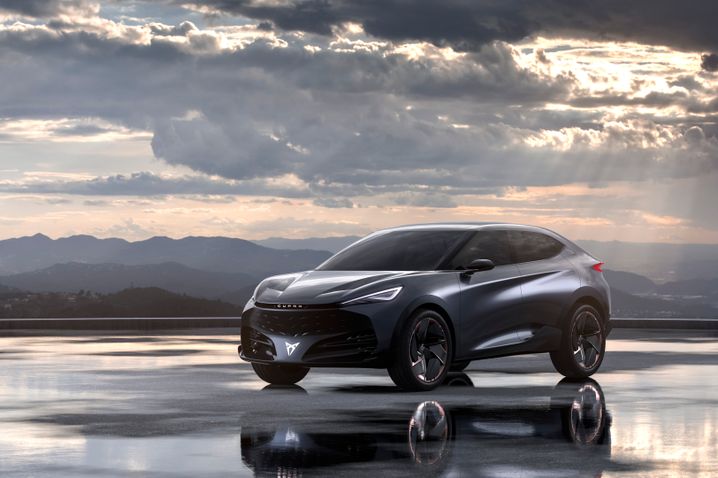The boss was joking. “Our Cupra customers average around 40 years old,” said Wayne Griffiths. “I drive a Cupra Formentor myself. I’m not 40 anymore, but I try to at least look like it.” Bleached undercut, sporty jacket, tight jeans, sneakers – that’s how he covered his 56 years when he appeared in Nürtingen on Thursday in front of around 500 visitors to the “Ifa Industry Summit”. With several automotive courses, the small town in the Swabian province is something of a cadre factory for the industry.
Semiconductor shortage, looming recession? Doesn’t matter. Griffiths doesn’t let the bad mood in the industry catch on. “All recent crises have helped us to become faster.”
However, this applies to Cupra. Not for Seat. And Griffiths is the boss of both.
The smaller offshoot was founded in 2018 by Griffiths’ Seat predecessor Luca de Meo (55), who is now French competitor Renault split up and restructure. Griffiths initially took over as Cupra boss in 2019, but then took over the seat leadership in 2020. And now manages in two speeds.
Cupra is likely to overtake the established Seat in the not too distant future. In the first half of the year, the Spaniards sold a total of 236,000 cars, 68,400 of them Cupras. A German dealer reveals that the future is already part of his everyday life: “Currently we sell 70 percent Cupra and 30 percent Seat.” The group is already questioning whether Seat will exist for a long time. Griffiths waves it off. “The combination of both brands makes us strong.”
But he knows where his focus should be if he wants to continue his career: at Cupra, a brand “that Volkswagen needs,” as he says. There is now a generation of customers who “want to drive something different than their grandparents and parents”. And the VW Group had no corresponding offer before Cupra. “All Volkswagen brands have prestige and tradition. But if Volkswagen wants to keep up with new competitors from China and the USA, Cupra can be an answer.”


Enlarge image
Planned for 2024: the electric Cupra Tavascan
Photo:
Seat
The brand wants to be sportier than Seat, but cheaper than Audi, for example. So far, the portfolio includes the beautified Seat models Leon and Ateca as well as the Cupra exclusive vehicles Born and Formentor. An additional electric SUV, the Tavascan, has been announced for 2024, and further electric cars are to follow by 2025. In 2030, Cupra wants to be purely an electrical product. In the medium term, the brand is planning annual sales of 500,000 units – in 2021 Seat and Cupra together delivered a good 470,000 new cars.
Sometimes without permission
In Spain, decisions are sometimes made without prior permission from the headquarters in Wolfsburg, Griffiths explained his pace management. “Of course we have to deliver.” In competition with newcomers such as the Chinese e-car specialist Nio, the Volkswagen Group offers advantages. “I’m happy that we didn’t have to start completely from scratch like others.” The Brit believes that anyone who wants to organize sales in Europe on their own will find it difficult. Volkswagen and thus also Cupra cover the entire area, “our dealer network is our strength”.
That’s why Cupra also maintains a particularly cooperative relationship with its dealers, Griffiths praised himself and his sales team. In retail, however, the ratio is rated less euphorically. In agency sales, the Cupra partners receive a fixed margin of four percent per car, and a further two percent can be added through performance-related bonuses. VW Pkw pays the same amount to dealers when they broker an electric car from the brand. Not every VW partner is happy with this
.
In contrast to the Wolfsburg-based company, Cupra even deducts another 1.9 percent for hedging returns via the Group’s Vehicle Trading International (VTI) company. “In the worst case, I only have a 2.1 percent margin on a car,” groans a dealer. Wayne Griffiths at least conceded on Thursday that the trading yield “is not yet at the target level”. You have to work on that.
Overall, the industry is still spoiled. “Sentiment is much worse than orders,” Griffiths said. “The next six months are still loosely covered” by orders, which applies to most car manufacturers. The incoming orders are getting worse, the customers kept their money together. But that too will be overcome.
Cupra is now planning in such a way that 70 percent of the planned sales are sufficient not to make a loss. However, the plan is not yet working out, at least in the overall business. In the first half of 2022, Seat and Cupra, with a joint loss of 97 million euros, were the only vehicle brands in the Volkswagen Group that did not make a profit.
more on the subject
Before the overall depressed mood in the Swabian province could spill over onto him, Wayne Griffiths quickly took to his heels again after a good half hour. “I’m going back to Spain now.” Not only is the weather better there, the atmosphere is too. And then, as a farewell, “Don’t be depressed.”
